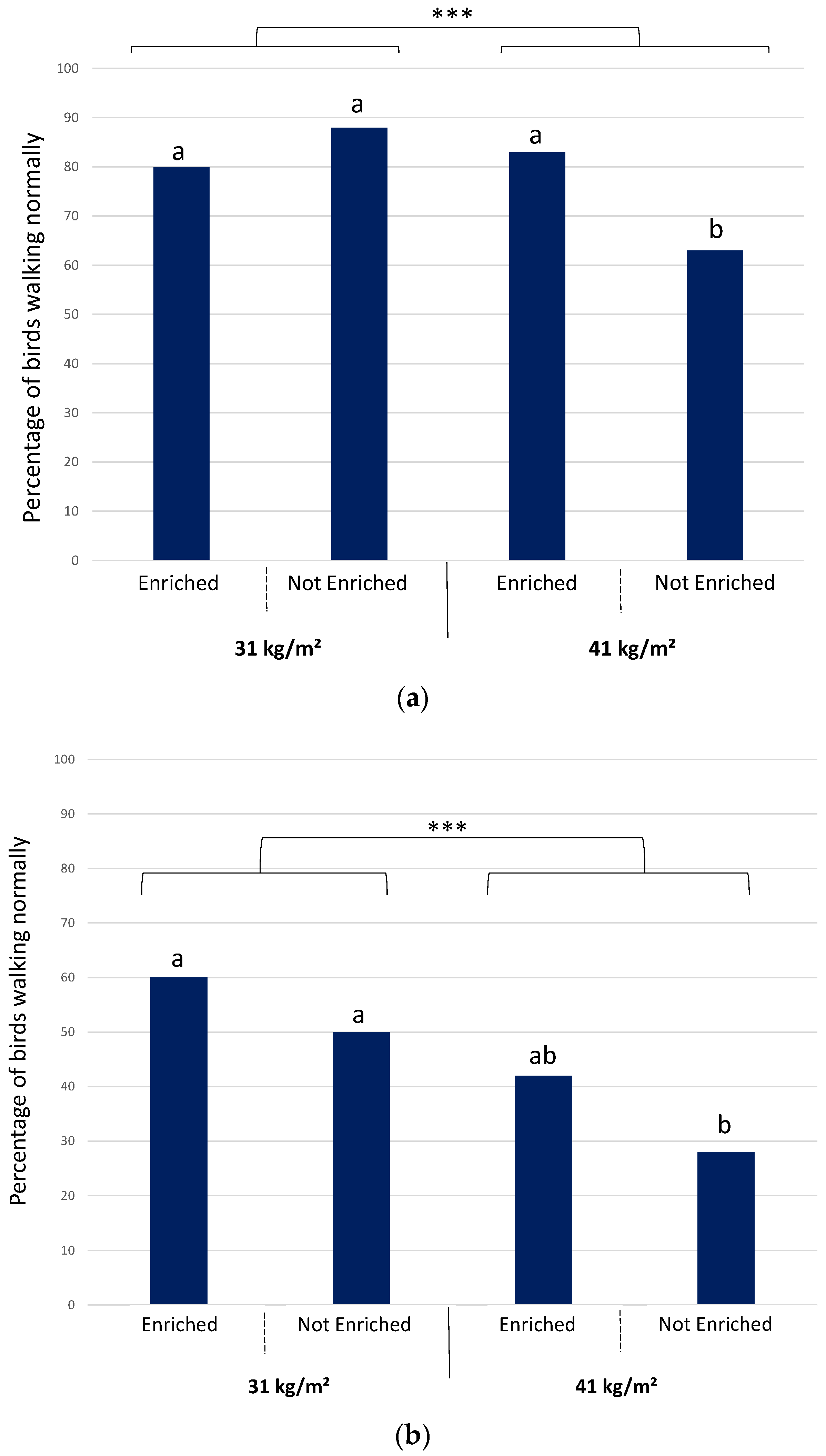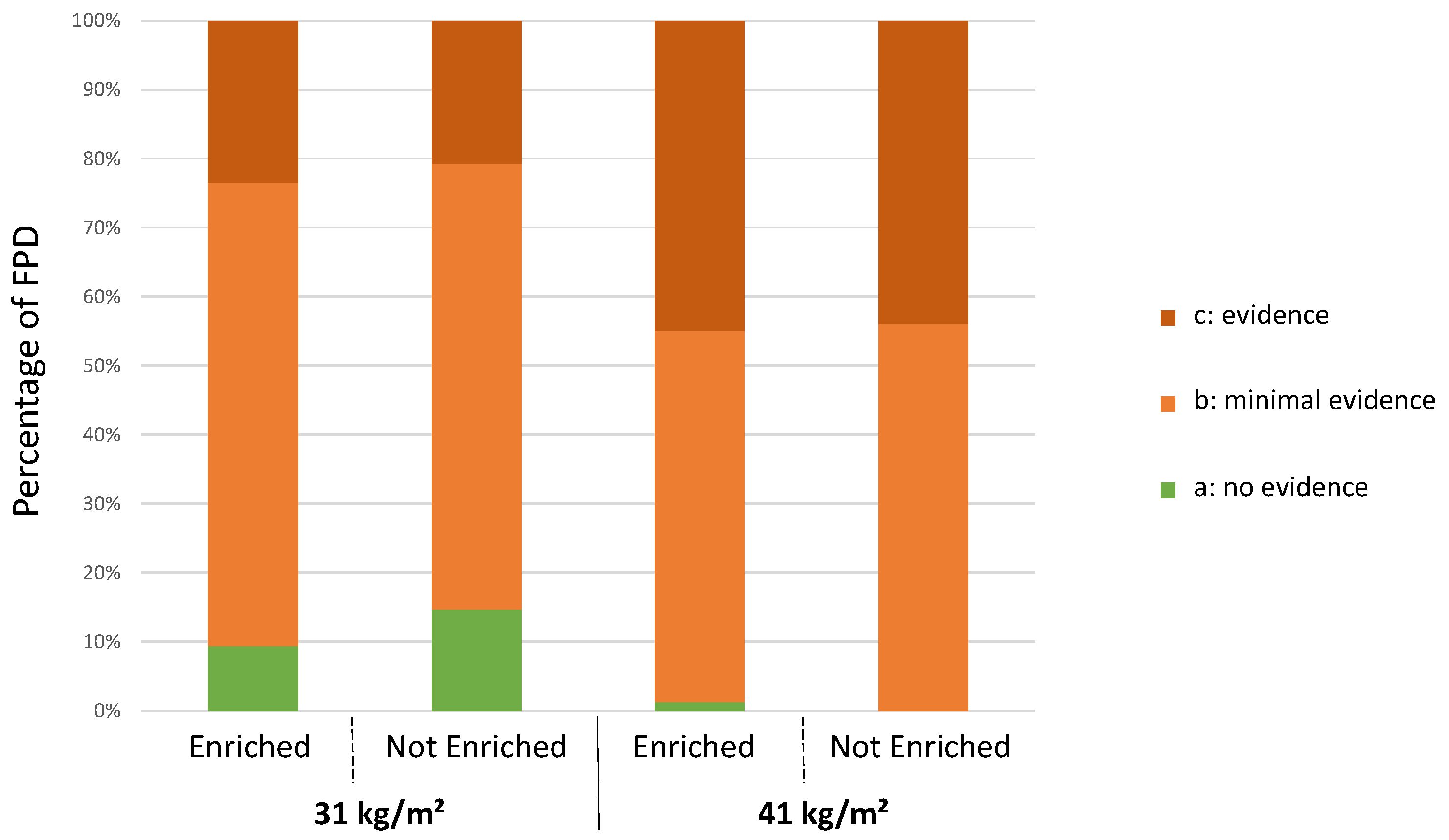Positive Effects of Elevated Platforms and Straw Bales on the Welfare of Fast-Growing Broiler Chickens Reared at Two Different Stocking Densities
Abstract
:Simple Summary
Abstract
1. Introduction
2. Materials and Methods
2.1. Housing and Experimental Design
2.2. Enrichments
2.3. Measurements
2.3.1. Litter Quality
2.3.2. Walking Ability
2.3.3. Body Weight, Mortality and Contact Dermatitis
2.3.4. Welfare Indicators Obtained Post-Mortem
2.4. Statistical Analysis
3. Results
3.1. Litter Quality
3.2. Weight and Mortality
3.3. Walking Ability
3.4. Welfare Indicators Assessed on the Farm
3.4.1. Footpad Dermatitis (FPD) at 25 Days of Age
3.4.2. Hock Burns at 25 Days of Age
3.5. Welfare Indicators Assessed Post-Mortem
3.5.1. Footpad Dermatitis
3.5.2. Hock Burns
4. Discussions
4.1. Contact Dermatitis and Litter Humidity
4.2. Walking Ability
4.3. Mortality and Weight
4.4. Platform Use and Impact on Stocking Density
5. Conclusions
Author Contributions
Funding
Institutional Review Board Statement
Informed Consent Statement
Data Availability Statement
Acknowledgments
Conflicts of Interest
References
- de Jong, I.C.; Berg, C.; Butterworth, A.; Estevez, I. Scientific report updating the EFSA opinions on the welfare of broilers and broiler breeders. Support. Publ. 2012, 9, 295E. [Google Scholar] [CrossRef]
- Newberry, R.C. Environmental enrichment: Increasing the biological relevance of captive environments. Appl. Anim. Behav. 1995, 44, 229–243. [Google Scholar] [CrossRef]
- Riber, A.B.; van de Weerd, H.A.; de Jong, I.C.; Steenfeldt, S. Review of environmental enrichment for broiler chickens. Poult. Sci. 2018, 97, 378–396. [Google Scholar] [CrossRef] [PubMed]
- Malchow, J.; Berk, J.; Puppe, B.; Schrader, L. Perches or grids? What do rearing chickens differing in growth performance prefer for roosting? Poult. Sci. 2019, 98, 29–38. [Google Scholar] [CrossRef] [PubMed]
- Bailie, C.L.; Baxter, M.; O’Connell, N.E. Exploring perch provision options for commercial broiler chickens. Appl. Anim. Behav. Sci. 2018, 200, 114–122. [Google Scholar] [CrossRef] [Green Version]
- Baxter, M.; Richmond, A.; Lavery, U.; O’Connell, N.E. Investigating optimal levels of platform perch provision for windowed broiler housing. Appl. Anim. Behav. Sci. 2020, 225, 104967. [Google Scholar] [CrossRef]
- Malchow, J.; Puppe, B.; Berk, J.; Schrader, L. Effects of elevated grids on growing male chickens differing in growth performance. Front. Vet. Sci. 2019, 6, 203. [Google Scholar] [CrossRef]
- Ventura, B.A.; Siewerdt, F.; Estevez, I. Effects of barrier perches and density on broiler leg health, fear, and performance. Poult. Sci. 2010, 89, 1574–1583. [Google Scholar] [CrossRef]
- Kaukonen, E.; Norring, M.; Valros, A. Perches & elevated platforms in commercial broiler farms: Use & effect on walking ability, incidence of tibial dyschondroplasia & bone mineral content. Animal 2017, 11, 864–871. [Google Scholar] [CrossRef] [Green Version]
- Chuppava, B.; Visscher, C.; Kamphues, J. Effect of different flooring designs on the performance and foot pad health in broilers and Turkeys. Animals 2018, 8, 70. [Google Scholar] [CrossRef] [Green Version]
- Liu, Z.; Torrey, S.; Newberry, R.C.; Widowski, T. Play behaviour reduced by environmental enrichment in fast-growing broiler chickens. Appl. Anim. Behav. Sci. 2020, 232, 105098. [Google Scholar] [CrossRef]
- Yang, X.; Huo, X.; Li, G.; Purswell, J.L.; Tabler, T.; Chesser, D.; Zhao, Y. Application of elevated perching platform and robotic vehicle in broiler production. In Proceedings of the 2019 ASABE Annual International Meeting, Boston, MA, USA, 7–10 July 2019. [Google Scholar]
- Jones, P.J.; Tahamtani, F.M.; Pedersen, I.J.; Niemi, J.K.; Riber, A.B. The productivity and financial impacts of eight types of environmental enrichment for broiler chickens. Animals 2020, 10, 378. [Google Scholar] [CrossRef] [PubMed] [Green Version]
- Pedersen, I.J.; Tahamtani, F.M.; Forkman, B.; Young, J.F.; Poulsen, H.D.; Riber, A.B. Effects of environmental enrichment on health and bone characteristics of fast growing broiler chickens. Poult. Sci. 2020, 99, 1946–1955. [Google Scholar] [CrossRef]
- Bach, M.H.; Tahamtani, F.M.; Pedersen, I.J.; Riber, A.B. Effects of environmental complexity on behaviour in fast-growing broiler chickens. Appl. Anim. Behav. Sci. 2019, 219, 104840. [Google Scholar] [CrossRef]
- Tahamtani, F.M.; Pedersen, I.J.; Riber, A.B. Effects of environmental complexity on welfare indicators of fast-growing broiler chickens. Poult. Sci. 2020, 99, 21–29. [Google Scholar] [CrossRef] [PubMed]
- Tahamtani, F.M.; Pedersen, I.J.; Toinon, C.; Riber, A.B. Effects of environmental complexity on fearfulness and learning ability in fast growing broiler chickens. Appl. Anim. Behav. Sci. 2018, 207, 49–56. [Google Scholar] [CrossRef]
- Ohara, A.; Oyakawa, C.; Yoshihara, Y.; Ninomiya, S.; Sato, S. Effect of environmental enrichment on the behavior and welfare of Japanese broilers at a commercial farm. J. Poult. Sci. 2015, 52, 323–330. [Google Scholar] [CrossRef] [Green Version]
- Bergmann, S.; Schwarzer, A.; Wilutzky, K.; Louton, H.; Bachmeier, J.; Schmidt, P.; Erhard, M.; Rauch, E. Behavior as welfare indicator for the rearing of broilers in an enriched husbandry environment—A field study. J. Vet. Behav. Clin. Appl. Res. 2017, 19, 90–101. [Google Scholar] [CrossRef]
- Baxter, M.; Bailie, C.L.; O’Connell, N.E. Evaluation of a dustbathing substrate and straw bales as environmental enrichments in commercial broiler housing. Appl. Anim. Behav. Sci. 2017, 200, 78–85. [Google Scholar] [CrossRef] [Green Version]
- Kells, A.; Dawkins, M.S.; Cortina Borja, M. The effect of a ‘freedom food’ enrichment on the behaviour of broilers on commercial farms. Anim. Welf. 2001, 10, 347–356. [Google Scholar]
- Bailie, C.L.; O’Connell, N.E. The effect of level of straw bale provision on the behaviour and leg health of commercial broiler chickens. Animal 2014, 8, 1715–1721. [Google Scholar] [CrossRef] [PubMed] [Green Version]
- European Commission. Council Directive 2007/43/EC of 28 June 2007 laying down minimum rules for the protection of chickens kept for meat production. Off. J. Eur. Union 2007, 182, 19–28. [Google Scholar]
- McLean, J.A.; Savory, C.J.; Sparks, N.H.C. Welfare of male and female broiler chickens in relation to stocking density, as indicated by performance, health and behaviour. Anim. Welf. 2002, 11, 55–73. [Google Scholar]
- Meyer, M.M.; Johnson, A.K.; Bobeck, E.A. Development and Validation of Broiler Welfare Assessment Methods for Research and On-farm Audits. J. Appl. Anim. Welf. Sci. 2020, 23, 433–446. [Google Scholar] [CrossRef]
- Welfare Quality®. Assessment Protocol for Poultry (Broilers, Laying Hens); Welfare Quality® Consortium: Lelystad, The Netherlands, 2009. [Google Scholar]
- R Development Core Team. R: A Language and Environment for Statistical Computing; R Foundation for Statistical Computing: Vienna, Austria, 2020. [Google Scholar]
- Kaukonen, E.; Norring, M.; Valros, A. Evaluating the effects of bedding materials and elevated platforms on contact dermatitis and plumage cleanliness of commercial broilers and on litter condition in broiler houses. Br. Poult. Sci. 2017, 58, 480–489. [Google Scholar] [CrossRef] [PubMed] [Green Version]
- de Jong, I.C.; Blaauw, X.E.; van der Eijk, J.A.J.; Souza da Silva, C.; van Krimpen, M.M.; Molenaar, R.; van den Brand, H. Providing environmental enrichments affects activity and performance, but not leg health in fast- and slower-growing broiler chickens. Appl. Anim. Behav. Sci. 2021, 241, 105375. [Google Scholar] [CrossRef]
- Dawkins, M.S.; Cain, R.; Merelie, K.; Roberts, S.J. In search of the behavioural correlates of optical flow patterns in the automated assessment of broiler chicken welfare. Appl. Anim. Behav. Sci. 2013, 145, 44–50. [Google Scholar] [CrossRef]
- Hepworth, P.J.; Nefedov, A.V.; Muchnik, I.B.; Morgan, K.L. Hock burn: An indicator of broiler flock health. Vet. Rec. 2011, 168, 303. [Google Scholar] [CrossRef]
- Haslam, S.M.; Knowles, T.G.; Brown, S.N.; Wilkins, L.J.; Kestin, S.C.; Warriss, P.D.; Nicol, C.J. Factors affecting the prevalence of foot pad dermatitis, hock burn and breast burn in broiler chicken. Br. Poult. Sci. 2007, 48, 264–275. [Google Scholar] [CrossRef] [Green Version]
- Ask, B. Genetic variation of contact dermatitis in broilers. Poult. Sci. 2010, 89, 866–875. [Google Scholar] [CrossRef]
- Kjaer, J.B.; Su, G.; Nielsen, B.L.; Sorensen, P. Foot pad dermatitis and hock burn in broiler chickens and degree of inheritance. Poult. Sci. 2006, 85, 1342–1348. [Google Scholar] [CrossRef] [PubMed]
- Hepworth, P.J.; Nefedov, A.V.; Muchnik, I.B.; Morgan, K.L. Early warning indicators for hock burn in broiler flocks. Avian Pathol. 2010, 39, 405–409. [Google Scholar] [CrossRef] [PubMed]
- Şekeroğlu, A.; Sarica, M.; Gulay, M.; Duman, M. Effect of Stocking Density on Chick Performance, Internal Organ Weights and Blood Parameters in Broilers. J. Anim. Vet. Adv. 2011, 10, 246–250. [Google Scholar] [CrossRef]
- Zuowei, S.; Yan, L.; Yuan, L.; Jiao, H.; Song, Z.; Guo, Y.; Lin, H. Stocking density affects the growth performance of broilers in a sex-dependent fashion. Poult. Sci. 2011, 90, 1406–1415. [Google Scholar] [CrossRef] [PubMed]





| Density | 41 kg/m2 | 31 kg/m2 | ||||||||||
|---|---|---|---|---|---|---|---|---|---|---|---|---|
| Room | Room 1 | Room 2 | Room 3 | Room 4 | Room 5 | Room 6 | ||||||
| Enrichment | Yes | No | Yes | No | Yes | No | No | Yes | ||||
| Pen | 1 | 2 | 3 | 4 | 5 | 6 | 7 | 8 | 9 | 10 | 11 | 12 |
| Number of broilers | 1385 | 1385 | 1471 | 1471 | 1385 | 1471 | 1040 | 1103 | 1103 | 1103 | 1040 | 1040 |
Publisher’s Note: MDPI stays neutral with regard to jurisdictional claims in published maps and institutional affiliations. |
© 2022 by the authors. Licensee MDPI, Basel, Switzerland. This article is an open access article distributed under the terms and conditions of the Creative Commons Attribution (CC BY) license (https://creativecommons.org/licenses/by/4.0/).
Share and Cite
Mocz, F.; Michel, V.; Janvrot, M.; Moysan, J.-P.; Keita, A.; Riber, A.B.; Guinebretière, M. Positive Effects of Elevated Platforms and Straw Bales on the Welfare of Fast-Growing Broiler Chickens Reared at Two Different Stocking Densities. Animals 2022, 12, 542. https://doi.org/10.3390/ani12050542
Mocz F, Michel V, Janvrot M, Moysan J-P, Keita A, Riber AB, Guinebretière M. Positive Effects of Elevated Platforms and Straw Bales on the Welfare of Fast-Growing Broiler Chickens Reared at Two Different Stocking Densities. Animals. 2022; 12(5):542. https://doi.org/10.3390/ani12050542
Chicago/Turabian StyleMocz, Frédérique, Virginie Michel, Mathilde Janvrot, Jean-Philippe Moysan, Alassane Keita, Anja B. Riber, and Maryse Guinebretière. 2022. "Positive Effects of Elevated Platforms and Straw Bales on the Welfare of Fast-Growing Broiler Chickens Reared at Two Different Stocking Densities" Animals 12, no. 5: 542. https://doi.org/10.3390/ani12050542
APA StyleMocz, F., Michel, V., Janvrot, M., Moysan, J.-P., Keita, A., Riber, A. B., & Guinebretière, M. (2022). Positive Effects of Elevated Platforms and Straw Bales on the Welfare of Fast-Growing Broiler Chickens Reared at Two Different Stocking Densities. Animals, 12(5), 542. https://doi.org/10.3390/ani12050542






